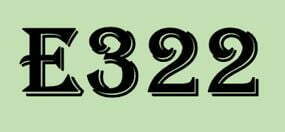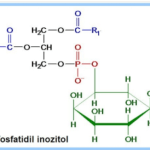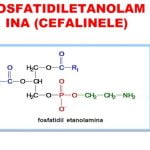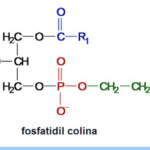What are E 322 lecithins?
Lecithins or E322 are food additives that can act as emulsifiers, stabilisers, antioxidants, humectants or lubricants.
Chemical name: lecithin or Phosphatidylcholine (PC)
Chemically they are phospholipids that yield by chemical or enzymatic hydrolysis (lecithins) apart from glycerol and higher monocarboxylic acids, phosphoric acid and an amino alcohol (choline, ethanolamine).[i]
How are lecithins obtained?
In nature lecithin is widespread in both the animal kingdom (egg yolk, brain, heart, liver) and the plant kingdom (sunflower seeds, maize, soya, cotton).
Industrial lecithin is obtained from soya beans, these contain 2.5-3.2% lecithin. Obtaining lecithin involves deoiling soybean oil by hydration with water or steam, followed by centrifugation. The crude lecithin preparation is brown in colour and is bleached by treatment with hydrogen peroxide. The preparation obtained contains: 29-43% phosphatidylcholine (PC), 21-43% phosphatidylethanolamine (PE), 21-34% phosphatidyl inositol (PI). It also contains phosphatidic acid (PF).
Lecithin can also be obtained by extracting the oil with an organic solvent (acetone or alcohol) and then evaporating it by vacuum distillation.[ii][iii
Figure 1. Structural formulae of the components making up the crude lecithin preparation
What are the specifications set for lecithins?
Under current legislation, lecithins must be of a certain composition and purity in order to be added as additives in food. The table below shows the specifications laid down and the permitted purity.
| Synonyms | Phosphatide; Phospholipid |
| Definition | Lecithins are mixtures or fractions of phosphatides obtained by physical procedures from foods of animal or vegetable origin; they also include hydrolysed products obtained by the use of suitable harmless enzymes. The final product must not show any signs of residual enzyme activity
Lecithins can be easily bleached in aqueous medium with hydrogen peroxide. This oxidation must not chemically alter the lecithin phosphates |
| Composition | Lecithins: not less than 60,0 % acetone-insoluble substances
Hydrolysed lecithins: not less than 56,0 % acetone-insoluble substances |
| Description | Lecithins: liquid, viscous semi-liquid or brown powder
Hydrolysed lecithins: light brown to brown viscous liquid or paste |
| Purity | |
| Loss on drying | Not more than 2,0 % (105 °C, 1 hour) |
| Toluene-insoluble substances | Not more than 0,3 |
| Acid value | Lecithins: not more than 35 mg potassium hydroxide/g
Hydrolysed lecithins: not more than 45 mg potassium hydroxide/g |
| Peroxide value | Less than or equal to 10 |
| Arsen | Not more than 3 mg/kg |
| Plumb | Not more than 2 mg/kg |
| Mercury | Not more than 1 mg/kg |
Which foods contain the food additive E 322?
Lecithins or E322 can be used in the following food products:
- Dehydrated milk as defined in Directive 2001/114/C,
- Practically anhydrous fats and oils (except anhydrous milk fat),
- Cocoa and chocolate products,
- Ice cream,
- Pastries,
- Salad dressings,
- Fresh pasta,
- Fresh pasta prepared in advance,
- Bread made exclusively from wheat flour, water, yeast or leavening agent, salt,
- Pain courant français; Friss búzakenyér, fehér és félbarna kenyere,
- Infant formulae as defined in Directive 2006/141/C,
- Processed cereal-based foods and baby foods for infants and young children as defined in Directive 2006/125/,
- Other foods for young children.
Lecithins E 322 may be used in nutritional preparations provided that the maximum level in – foods for infants and young children is not exceeded
Lecithins can be used as carriers in fat-soluble dyes and antioxidants.[iv]
What else can E 322 be used in?
Lecithins E 322 can also be used in:
- medicine, to alleviate the symptoms of certain diseases (gastritis, ulcers and colitis, psoriasis, dermatitis, etc.),
- cosmetic industry (in skin care, hair care and decorative cosmetics),
- production of paints, solvents,
- ink production,
- fertiliser production,
- production of explosives.
Are there any side effects from consuming the food additive E 322?
Lecithins E 322 do not pose a health risk to the consumer. They belong to the class of phosphatides, are normal constituents of the animal body, which, among other functions, are surface active agents, thus playing an important role as regulators of cell membrane permeability.
Lecithins contribute to the transport of fat in the animal body (and to the formation of milk fat in the mammary gland), as well as to the transmission of nerve excitation.
Lecithins:
– improves the food utilization coefficient, promoting growth and development of the body;
– increase physical and intellectual work capacity;
– speeds up the body’s recovery after intense exertion.1
What are the permissible doses for the additive E 322?
Maximum daily amount allowed/body: There is no limit to the daily dose allowed.
Description of the maximum daily amount allowed: There is no limit to the daily dose allowed.
Intake dose in food
- The incorporation level in anhydrous fats and oils (excluding anhydrous milk fat) is 30 000 mg/l excluding virgin oils and olive oils.
- The dose for incorporation into infant formulae is 1 000 mg/kg.
- The intake level in processed cereal-based foods and foods for infants and young children is 10 000 mg/l (biscuits and cereal-based foods, baby foods only).
- Other foods for young children 10 000 mg/kg
Why is it necessary to use the additive E 322?
The use of E322 is a necessity in the food industry due to its functional properties as an emulsifier, stabiliser and antioxidant.
As an emulsifier, lecithins contribute to the formation of emulsions (i.e. those dispersed systems obtained from two immiscible liquids, acting by lowering the surface tension at the phase interface).
As a stabiliser of a formed food emulsion, lecithin is adsorbed on the surface of the dispersed particles and thus prevents separation of the two liquids (emulsion breakage) by an electrical repulsion effect, and in some emulsifiers also sterically.
Lecithins form oil-in-water (O/W) emulsions, being hydrophilic emulsifiers.
In the case of chocolate, lecithin is needed during conching (mixing the chocolate mass at temperatures of 45-70°C for 24 hours) to reduce the viscosity of the chocolate mass, which thus acquires a certain creaminess.
In pasta, the additive E 322 increases the strength of the finished product, so that it does not break, become sticky, have a smooth surface, etc. when boiled.
In bakery products, lecithin is used to process gluten and short gluten flours.
The role of the additive E322 is to reduce the elasticity of gluten, increase its hydration capacity, retain gases (carbon dioxide), which contributes to the increase in volume and porosity of the products concerned.
The emulsifier has the property of forming complex combinations with the gluten proteins in the flour. The use of lecithin in bread making is important because of its action as an anti-ageing agent, explained by its tendency to complex amylose, thus preventing its retrogradation.
Lecithin added to vegetable and animal oils and fats also acts as an antioxidant, blocking their oxidation (rancidity) processes.1
How many categories do food additives fall into?
The World Health Organization (WHO)[v] has grouped food additives, based on their function, into 3 broad categories as follows:
- Flavouring agents. These are added to foods to improve flavour or taste. Flavour enhancers are most commonly used in foods. There are hundreds of types of flavourings used in a wide variety of foods, from confectionery and soft drinks to cereals, cakes and yoghurt.
- Enzymes or enzyme preparations. They can be obtained by extraction from plants or animal products or from micro-organisms such as bacteria and are used as alternatives to chemical-based technology.
Enzyme preparations are mainly used in baking (to improve dough), fruit juices, wine and beer making (to improve fermentation) and cheese making (to improve curd formation).
- Other additives. These are used for a number of reasons, such as: preservation, colouring and sweetening. They are added when food is being prepared, packaged, transported or stored and eventually become a component of the food.
- Conclusions and Legislative Regulations E 322
Lecithins or E 322 are regulated under European legislation[vi] and European Regulation No 1333/2008.
This additive is permitted in foods for infants and children within the limits required by law.
If more than one of E 322, E 471, E 472c and E 473 is added to a food, the maximum level set for that food for each of these substances shall be reduced in proportion to the cumulative amount of the other substances in that food. 5
Author: dr. ing. Ancuta Fulvia Manolache
Bibliographical references
[i] Elena Olănescu, Food Additives-necessity and risk, SemnE Publishing House, 2005, Bucharest,
[ii] Raluca Stan, Natural and synthetic food additives, Printech Publishing House, 2007,
[iii] Constantin Banu, Applications of additives and ingredients in the food industry, ASAB Publishing House, 2010, pp. 126-127
[iv] Regulation (EC) No 1333/2008 of the European Parliament and of the Council of 16 December 2008 on food additives
[v] https://www.who.int/news-room/fact-sheets/detail/food-additives
[vi] https://webgate.ec.europa.eu/foods_system/main/index.cfm?event=substance.view&identifier=115
8 https://pixabay.com/ro/photos/banane-desert-dulciuri-frisca-282313/




